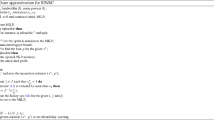Abstract
Radio traffic congestion occurs in a radio network when too many users simultaneously transmit on the same channel within close geographical proximity. Such congestion can be prevented by imposing channel loading constraints, which restrict the number of users that can operate using the same channel at one instance in time. Channel loading constraints are a variety of non-binary constraint that can be represented as subsets of transmitters which cannot operate on the same channel. This makes the computational cost in generating and storing them significant.
In this paper we present an efficient technique for making an assignment when channel loading constraints are imposed. The method is suitable for implementation on large problem instances. We also propose a technique for finding a lower bound on the minimum span of channels required. The methods we introduce are well suited to the channel loading problem as they eliminate the need for explicit generation of the constraints involved.
Similar content being viewed by others
References
S.M. Allen, D.H. Smith and S. Hurley, Lower bounds for the frequency assignment problem, Discrete Mathematics 197-198 (1999) 41–52.
R. Carraghan and P.M. Pardalos, An exact algorithm for the maximum clique problem, Operations Research Letters 9 (1990) 375–382.
D. Castelino, S. Hurley and N.M. Stephens, A tabu search algorithm for frequency assignment, Annals of Operational Research 63 (1996) 301–319.
F. Glover, Heuristics for integer programming using surrogate constraints, Dec. Sci. 8 (1977) 156–166.
F. Glover, Future paths for integer programming and links to artificial intelligence, Comp. Oper. Res. 13 (1986) 543–549.
R.A.H. Gower and R.A. Leese, The sensitivity of channel assignment to fit constraint specification, in: Proceeding of ETC '97 Symposium, Zurich (1997) pp. 131-136.
S. Hurley, D.H. Smith and S.U. Thiel, FASoft: A system for discrete channel frequency assignment, Radio Sci. 32(5) (1997) 1921–1939.
S. Hurley and D.H. Smith, Bounds for the frequency assignment problem, DiscreteMathematics 167-168 (1997) 571–582.
S. Hurley, D.H. Smith and C.L. Valenzuela, A permutation based genetic algorithm for minimum span frequency assignment, in: PPSN '98 (September 1998).
S. Limb, Investigation into the problem of continental interference in the UK in the frequency band 450-470 MHz, M.P. thesis, University of Bradford (August 1998).
R.C.V. Macario, Modern Personal Radio Systems (Institution of Electrical Engineers, London, 1996).
D.H. Smith, S.M. Allen, S. Hurley andW.J.Watkins, Frequency assignment: methods and algorithms, in: Proceedings of the NATO RTA SET/ISET Symposium on Frequency Assignment, Sharing and Conservation in Systems (Aerospace), Aalborg, Denmark, NATO RTO-MP-13 (1999) pp. K-1-K-18.
Author information
Authors and Affiliations
Rights and permissions
About this article
Cite this article
Hurley, S., Whitaker, R.M. & Smith, D.H. Channel Loading in Private Mobile Radio Networks. Annals of Operations Research 107, 211–224 (2001). https://doi.org/10.1023/A:1014907300704
Issue Date:
DOI: https://doi.org/10.1023/A:1014907300704




